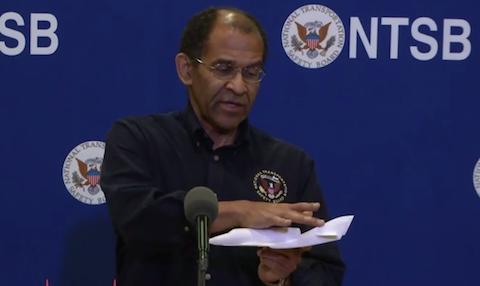The following is an overview of the preliminary findings presented by the NTSB on the third day of their investigation.
During the fourth media briefing on the third day of the on site portion of the NTSB investigation of the crash of SpaceShipTwo, the most significant information provided by acting NTSB chair Christopher A. Hart was a general timeline of the events between the release of SpaceShipTwo from its mothership WhiteKnightTwo, and the loss of telemetry from SpaceShipTwo. In that roughly fifteen second span, a number of events occurred inside SpaceShipTwo:
- SpaceShipTwo released from mothership WhiteKnightTwo at 10:07:19 PDT (17:07:19 UTC)
- The rocket engine was ignited about two seconds later.
- About eight seconds later, and 10 seconds after release, SpaceShipTwo was traveling at about Mach 0.94
- Sometime during the next two seconds, the feather lock handle was moved from the locked to the unlock position by the person sitting in the right seat.
- At about 12 seconds after release, the vehicle was traveling at Mach 1.02
- The feathers began to deploy at about 13 seconds after release.
- Telemetry and video data was lost about two seconds later, roughly 15 seconds after release.
In addition to the timeline, the NTSB stated that lightweight debris was recovered about 30-35 miles northeast of the main wreckage area, and it was not clear what role wind may have played in the distribution of that wreckage. Also, while there was clear evidence that the pilot in the right seat moved the feather lock handle, during the media briefing, Hart was not clear if it was the pilot or the copilot who did so.
Shortly after the media briefing, NTSB clarified its position on Twitter, stating that the copilot, who did not survive the mishap, was the person in the right seat who moved the lock/unlock handle into the unlocked position.
Additional resources
Initial NTSB SpaceShipTwo accident investigation
Review of first two NTSB briefings on 1 November 2014
Review of third NTSB briefing on 2 November 2014
Review of fourth NTSB briefing on 3 November 2014












